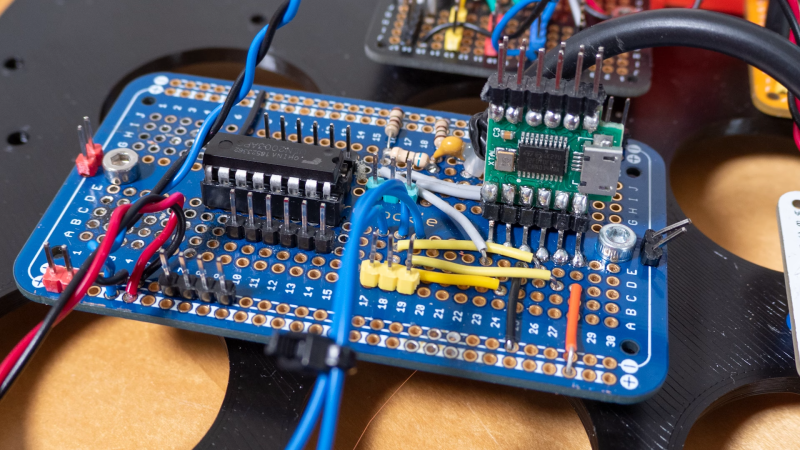Crystals are key to a lot of radio designs. They act as a stable frequency source and ensure you’re listening to (or transmitting on) exactly the right bit of the radio spectrum. [Q26] decided to use the ProgRock2 “programmable crystal” to build a receiver that could tune multiple frequencies without the usual traditional tuning circuitry.
The ProgRock2 is designed as a tiny PCB that can be dropped into a circuit to replace a traditional crystal. The oscillators onboard are programmable from 3.5KHz to 200 MHz, and can be GPS discliplined for accuracy. It’s programmable over a micro USB pot, and can be set to output 24 different frequencies, in eight banks of three. When a bank is selected, the three frequencies will be output on the Clock0, Clock1, and Clock2 pins.There was some confusion regarding the bank selection on the ProgRock2. It’s done by binary, with eight banks selected by grounding the BANK0, BANK1, and BANK2 pins. For example, grounding BANK2 and BANK0 would activate bank 5 (as 101 in binary equals 5). Once this was figured out, [Q26] was on top of things.
In his design, [Q26] hooked up the ProgRock2 into his receiver in place of the regular crystal. Frequency selection is performed by flipping three switches to select banks 0 to 7. It’s an easy way to flip between different frequencies accurately, and is of particular use for situations where you might only listen on a limited selection of amateur channels.
For precision use, we can definitely see the value of a “programmable crystal” oscillator like this. We’ve looked at the fate of some major crystal manufacturers before, too. Video after the break.















Most folks making new designs would just use the Sis5315A chip directly. These are nice for retrofit of a vintage radio where design is not necessary. Be aware of the technical limitations of most frequency synthesizers: phase noise limits the performance of both the receiver and the transmitter. Be especially careful about chips that quote jitter rather than phase noise, they probably weren’t made for a high-performance radio application.
Not everyone wants to procure/fab/learn/ program a device which can be bought for $20 or so, any more than they want to grow a slab of quartz and grind it. I’m sn inveterate homebrewer but part of that reason is for economy. At 76 years old, do I really want to invest the time in learning to program microchips? I want to solder the pieces together and get it going.
And the phase noise of this device is pretty respectable.
“It’s a crystal radio”
Is phase noise not a problem? I thought this little toys are a little bit bad at this point.
Olaf
Given that this is typically used for shortwave radio and not anything requiring super low noise, it is not an issue. Si5351 has the phase noise low enough for this to not be a problem.
Silicon Laboratories (SiLabs) used to make a very low phase noise/jitter programmable clock generator called the Si570. Most people eschewed this venerable part for the arguably “good enough and cheaper” Si5351 clock generator chip, especially for radios at lower frequencies where naturally occurring noise dominates system design. The real even-more often overlooked and/or ignored icing on the cake chip comes in the form of the SiLabs Si571 which has all the goodness of the Si570, but allows you to use an external reference in the Si571’s phase-locked-loop. It should be noted that some time back, Silicon Laboratories sold all of its clock and radio (SDR) product line to Skyworks Solutions.[1] The Si570 is rather hard to find these days, but there is a dedicated few out there who still covet the part. The Si571 is even harder to come by, but can be bought if your pockets are deep enough or you can arrange a group buy.
TI makes the LMK61E2 156.250-MHz, ±50 ppm, ultra-low jitter, integrated EEPROM, fully programmable oscillator, which in certain configurations can hands-down beat the Si570.[2][3] But the LMK61E2 is a beast to use and buy, especially if you want to externally reference it.
* References:
1. Skyworks Solutions Inc.
https://www.skyworksinc.com/
2. Texas Instruments LMK61E2 156.250-MHz, ±50 ppm, ultra-low jitter, integrated EEPROM, fully programmable oscillator
https://www.ti.com/product/LMK61E2
3. Potential replacement for SI570
https://groups.io/g/softrock40/message/87351
My phase noise measurements on the Si5351A are here:
https://qrp-labs.com/synth/phasenoise.html
Phase noise is pretty low and isn’t a problem even in a high performance radio.
The IC is used in a number of high performance transceivers including Elecraft KX2, QRP Labs QCX+/mini and QDX.
Could you change the frequency outputs on the fly to make a poor man’s frequency hopping radio? I’m not even sure frequency hopping is legal on civilian radios, but it would be pretty cool for some low level short term privacy. Would be interesting to listen to a bunch of older hams trying to do a time hack over the air, hundreds of miles away. I remember what a headache it could be when our military radios were less than 100ft away from each other. Had to be within three seconds of each other to lock onto the master radio and fall in sync. Always had a few that would fail and would need to be keyed in again.
Visit Hans Summets QRP Labs sire and see what he has.
My apologies for misspelling Hans Summers’ name; old eyes, fat fingers.
Time sync is easy with GPS